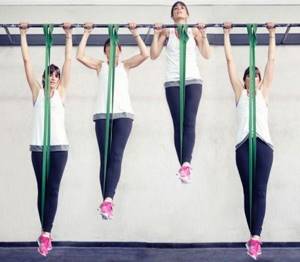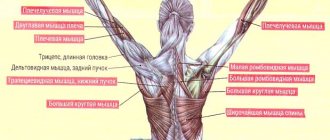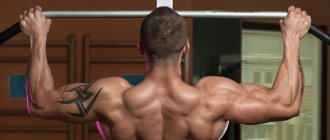Preparation
The process may be hindered by:
- Overweight: If you weigh more than 80 kg, you must first lose those extra pounds to avoid injury.
- Poorly developed muscles of the upper body.
- Lack of such practice before.
- Unproven technique and, as a result, errors in execution.
- Ignoring the supply complex.
Before you start doing pull-ups, you need to prepare your core and stabilizing muscles, ligaments and joints. The success of this exercise is not guaranteed even by the fact that the athlete easily lifts dumbbells or a barbell with a large weight. Therefore, it is very important to completely develop the body in advance using a special technique - we’ll talk about it below.
Partner training
The most effective pull-up is with a partner who takes a position from behind and, supporting the legs or in the lower back, slightly helps to pull up.
The number of repetitions per approach gradually increases, and when their number reaches 8-10, a person is quite capable of doing pull-ups without outside support.
What exercises to start with
For beginners, there is a certain complex that allows you to speed up the learning process:
- Hold. Stand on the springboard under the horizontal bar and jump up to the top position, tensing your back muscles and trying to stay at the top in this position for at least twenty seconds.
- Reverse pull-up. Stand on an additional elevation and jump up, holding the horizontal bar for a couple of seconds, and then begin to slowly lower to the starting position for five seconds. Perform three sets of five repetitions.
- Horizontal pull-ups on a low bar are performed from a lying position. You need to grab the horizontal bar and lean back so that your torso is parallel to the floor. Focusing on your heels, pull your chest toward the horizontal bar. Perform three sets of fifteen repetitions.
- A lightweight version using an expander thrown over a horizontal bar. Place your feet on the machine and start moving upward. Perform at least two sets of ten times.
- Pull-ups for shoulder blades: move them as close to each other as possible, stretching out on the horizontal bar. Hold this position for a couple of seconds and relax your muscles. Perform three sets of ten repetitions.
- Work with a small number of repetitions in the first two weeks - twice for 5-6 approaches.
Pull-up programs
The optimal result when practicing according to the schemes that will be proposed below can be achieved if you change the type of grip every day. That is why both schemes for increasing pull-ups on the horizontal bar will be presented in six-day cycles over four weeks. It makes no sense to proceed to this guide without studying in detail the techniques and grips for pull-ups on the horizontal bar.
Reverse progression method
- The first day. Six approaches to the horizontal bar: 1 - 5 pull-ups, 2 - 4, 3 - 3, 4 - 2, 5 - 1, 6 - 1. The first approach begins with sagging on straight arms for 10 seconds, and the sixth approach ends with the same sagging (this relevant for each day of classes if the first or second technique is used).
- Second day. Six approaches: 1 - 6, 2 - 5, 3 - 4, 4 - 3, 5 - 2, 6 - 1.
- Day three. Six approaches: 1 - 7, 2 - 6, 3 - 5, 4 - 4, 5 - 3, 6 - 2.
- Day four. Six approaches: 1 - 7, 2 - 6, 3 - 5, 4 - 4, 5 - 3, 6 - 3.
- Day five. Six approaches: 1 - 8, 2 - 7, 3 - 6, 4 - 5, 5 - 4, 6 - 4.
- Day six. Six approaches: 1 - 8, 2 - 7, 3 - 6, 4 - 5, 5 - 5, 6 - 5.
The next day you need to take a break to restore the body and consolidate the results. After this, a new six-day period and so on for four 6 days. Then they change the pull-up technique.
Direct progression method
- The first day. Three approaches to the horizontal bar: 1 - 5 pull-ups, 2 - 5, 3 - 5.
- Second day. Three approaches: 1 - 6, 2 - 6, 3 - 6.
- Day three. Three approaches: 1 - 6, 2 - 6, 3 - 6.
- Day four. Three approaches: 1 - 7, 2 - 7, 3 - 7.
- Day five. Three approaches: 1 - 7, 2 - 7, 3 - 7.
- Day six. Three approaches: 1 - 8, 2 - 8, 3 - 8.
The next day involves a break, and then - according to the recommendations of the “reverse progression method”.
Both of the above tables of pull-ups on the horizontal bar are designed for the initial training of an athlete. If we are talking about more significant preparation of the practitioner, then from the second week the load can be doubled, further increasing according to individual instructions. However, the total daily number of pull-ups should not exceed one hundred in the first year of working with the circuits.
If we are talking about a person who knows about physical activity only by hearsay, then before using the pull-up schedule on the horizontal bar, he needs to take a preparatory course of push-ups using the reverse or direct progression method. This will prepare you for more serious loads and productive exercises.
Pull-up technique
To achieve the greatest effect, you must follow certain rules:
- Keep your back, shoulders and muscles around the collarbones and shoulder blades tense, with your arms extended, but the body should not hang completely, otherwise the main load falls on the weak biceps ligaments, and this is extremely undesirable.
- When lifting up, you need to use not only your arms: as your elbows move towards your ribs, your shoulder blades should be pulled down and back.
- Try to finish the pull-up. When your chin is above the bar, you need to strive to rise higher, squeezing your shoulder blades and maintaining tension in your abdominal muscles and buttocks. The torso can be slightly tilted back, but the shoulders should not go beyond the level of the horizontal bar - this can lead to joint injury.
- Maintain proper breathing: exhale - up, inhale - down.
How to do pull-ups correctly
Many novice athletes want to independently develop a pull-up system for themselves on the horizontal bar. Of course, no beginner can do 50 pull-ups, which is why many of them strive to achieve good results through their efforts. Unfortunately, most people fail to do this, because not every person who has not previously been involved in sports knows how to do pull-ups correctly. Because of this, people get injured instead of the desired result, but it is much easier to spend time studying the theory than recovering from your own reckless actions.
When doing pull-ups, your back and legs must be straight. It is necessary to raise the body until it stops so that the chin touches the bar. The horizontal bar contains many secrets that can lead to the success of any athlete. Fortunately, there is no need to solve them, because other people have already done this a long time ago:
- In order to increase mass, it is necessary to rise as slowly as possible, and, on the contrary, to descend quickly.
- To strengthen muscles and increase endurance, you will need to climb quickly, but you will have to descend slowly.
- To improve stretching and flexibility, you should go up and down at a fast pace, and in the periods between approaches it is recommended to simply hang on the horizontal bar for ten seconds.
Types of pull-ups
The exercises can be performed in several ways. Let's take a closer look at them.
Medium overhand grip
Classic version with an emphasis on pumping the muscles of the back and biceps:
- place your hands shoulder-width apart;
- hang with your back slightly arched;
- cross your legs to better support your body;
- begin to pull yourself up, bringing your shoulder blades together;
- touch the bar with your upper chest;
- descend smoothly.
Medium underhand grip
An easier method, in which the main part of the load falls on the biceps. The principle of performing this exercise is similar to the previous one, the only difference is in the location of the palms: they are turned not away from you, but towards you. When moving up, the shoulders are pulled back and then down, the forearms remain perpendicular to the surface all the time.
Wide grip to chest
This type is considered the most effective for working out the trapezius, teres paired and latissimus dorsi muscles, however, it requires certain physical preparation - it is very difficult for beginners to perform this exercise:
- grab the bar from above, placing your hands at the same distance as when pressing a barbell from a lying position;
- Place all five fingers on top for maximum muscle stretching;
- start doing pull-ups without straining your biceps and bringing your shoulder blades together;
- stretch up until your chest touches the bar;
- linger at the extreme point for a few seconds and gradually lower.
Wide head grip
A popular variety of pull-ups aimed at strengthening the back muscles, especially the latissimus group. Often performed incorrectly - the main mistake is the immobility of the shoulder joints:
- grab the bar in the same way as when doing a bench press;
- keep your back straight - bending can lead to injury;
- Place your legs and body on the same line;
- keep your elbows pointed down and not pulled back;
- when rising, make sure that your neck does not touch the bar at the top point;
- slowly return to the starting position.
Narrow overhand grip
This exercise is great for people with stiff wrists and works the brachialis, lower latissimus and serratus dorsi muscles:
- position your palms on the horizontal bar so that your thumbs are as close to each other as possible;
- begin to pull yourself up, arching your back;
- touch the bar with your lower chest;
- not in a hurry to go down.
Narrow underhand grip
This exercise helps to stretch the latissimus dorsi muscles and work the biceps:
- place your hands close to each other, with your palms facing you;
- bring your shoulder blades together, pull your shoulders back and begin to rise, bending your back as much as possible when you reach the extreme point;
- touch the bar with your lower chest;
- go down slowly.
Reverse grip
One of the most popular ways for a girl or beginner to learn how to do pull-ups on a horizontal bar: the exercise involves the biceps brachii, latissimus, lower trapezius and oblique abdominal muscles:
- place your hands on the horizontal bar at shoulder width, elbows parallel to the body;
- tighten your abdominal and leg muscles;
- cross your legs and bend your knees;
- start moving upward, trying to touch the crossbar with your chest;
- descend smoothly.
For beginners, at first you can only do pull-ups with a reverse grip, but gradually you need to master the direct method - this will help work out a large group of muscles.
With swing
The exercise is mainly used in CrossFit and provides additional stress on many muscle groups:
- grab the bar with an overhand grip, placing your hands shoulder-width apart;
- retract your shoulder blades and swing your legs back so that your torso leans forward;
- tighten your pectoral muscles and, pushing off with your hips, swing your legs forward;
- pull your chin to the bar;
- having started moving down, swing your legs back, simulating pushing off the crossbar;
- drop down sharply, straightening your arms.
Different types of hand positioning and grip allow you to work with different muscle groups of the upper body, improving the body without the use of additional load and exercise equipment. However, you can always complicate the exercise: just use one hand or use weights - for example, a backpack with a load.
Exercises on the horizontal bar
People often turn to the pull-up system in order to develop muscles and perform more complex exercises. Indeed, the crossbar provides a fairly wide field for the athlete’s imagination. With this apparatus you can perform incredible tricks and exercises that develop various muscle groups.
The most popular exercises are presented below. They attract the attention of not only men, but also women, even despite their complexity.
After completing the individual system of pull-ups on the horizontal bar, in a month you will achieve significant results, these exercises will seem easy, and you can no longer hesitate to perform them on the street or in the gym.
Recommendations for beginners
Knowing how to do pull-ups correctly, you can avoid many injuries and mistakes, so pay attention to the following nuances:
- You can start the exercise only after the muscles are sufficiently strong. To develop strength and endurance, pumping your arms and forearms is necessary, so include deadlifts, barbells and dumbbells in your training.
- Remember: a proper pull-up requires a firm grip and active, strong shoulders. A great way to achieve this is to increase your hang time. To carry out a set of ten repetitions, you need to be able to hold on to the horizontal bar for 40 seconds - this is a necessary condition for beginners, so as not to slip off the horizontal bar at the most inopportune moment. Every day you should add two seconds until the hang time reaches a minute. Train 3-5 times - and in a month you will be able to fully do pull-ups. However, do not forget about moderation: when performing the exercise, be sure to give your body a rest.
- Beginning athletes should avoid jerking pull-ups to avoid injury - this method is popular in CrossFit and requires a more serious level of training from athletes.
- To complete a full approach, you need to properly work the muscles of your back and arms. Additionally, TRX and rings can help with this - techniques allow you to vary the intensity and increase the load, using almost the entire body weight.
- Beginners should not swing until they can do at least five pull-ups - the exercise requires controlling body weight, and beginner athletes do not cope with this task right away. As your level increases, you should definitely introduce rocking into your program - they give your shoulders more load, allowing you to work more dynamically.
- A great exercise for building strength is the rope climb. The athlete needs to push off from the tourniquet, clinging to it with his feet, and at the same time grab as high as possible, pulling his body along with him. This method quickly trains the body to achieve results as quickly as possible.
Tips for pull-ups on the horizontal bar
The tips described below are mostly true for beginners, but experienced athletes can also find useful information.
Correct technique is key!
- Constantly work on improving your technique, especially in the early stages of training.
Without proper execution of pull-ups, you will not see any results.
We repeat once again, do not chase results! Perform each repetition cleanly and under control. - Train pull-ups no more than 3 times a week.
- Even four or five workouts a week can drive an athlete into overtraining and take him out of the training process for a long time. Two to three workouts per week will be enough (in the beginning). Experienced athletes can exercise much more often.
- Don't forget about recovery.
- Healthy sleep and proper nutrition are a must.
The result will not increase continuously if recovery is neglected. Be less nervous, eat and sleep more, then progress is inevitable. If necessary, you can use sports nutrition, but don’t get carried away.
Straps
Experienced athletes can use straps in two cases. We have already discussed the first, it is associated with better development of the back. The second involves the use of straps when working with a lot of additional weight. There are athletes who do pull-ups with a weight of 60 and even 70 kilograms, so the second case is true for them.
A beginner should not use straps to strengthen his grip and build muscle on his forearms.
Deal with the problems that are preventing you from doing a lot of pull-ups
If you weigh about a hundred kilograms or more, and this is not muscle mass, then you will have to forget about a good result in pull-ups until you lose weight.
Excess weight is one of the main reasons for the inability to do at least one pull-up.
Don't jump off the horizontal bar
After completing the next approach, many guys fly down like a sack of potatoes, having previously swung strongly. This is strictly prohibited.
Why? The moment your feet touch the ground, the load on your joints is enormous. The spine and knee joints suffer the most.
Additional weight
After some period of time, you will have to buy a belt for additional weight.
Otherwise, only endurance will be trained, and strength and muscles will remain at the same level due to lack of load.
Exercises with safety net
When studying independently at the initial stages, you can take care of the availability of insurance:
- The classic method is carried out using a stool, standing on which you can pull yourself up, hovering in the upper position for a few seconds.
- The use of rubber, which is tied to the belt and helps during the exercise. In just a few days you will be able to pull yourself up without her help.

- When exercising in fitness rooms, you can use a special simulator - a gravitron. It works on the principle of counterweight.











